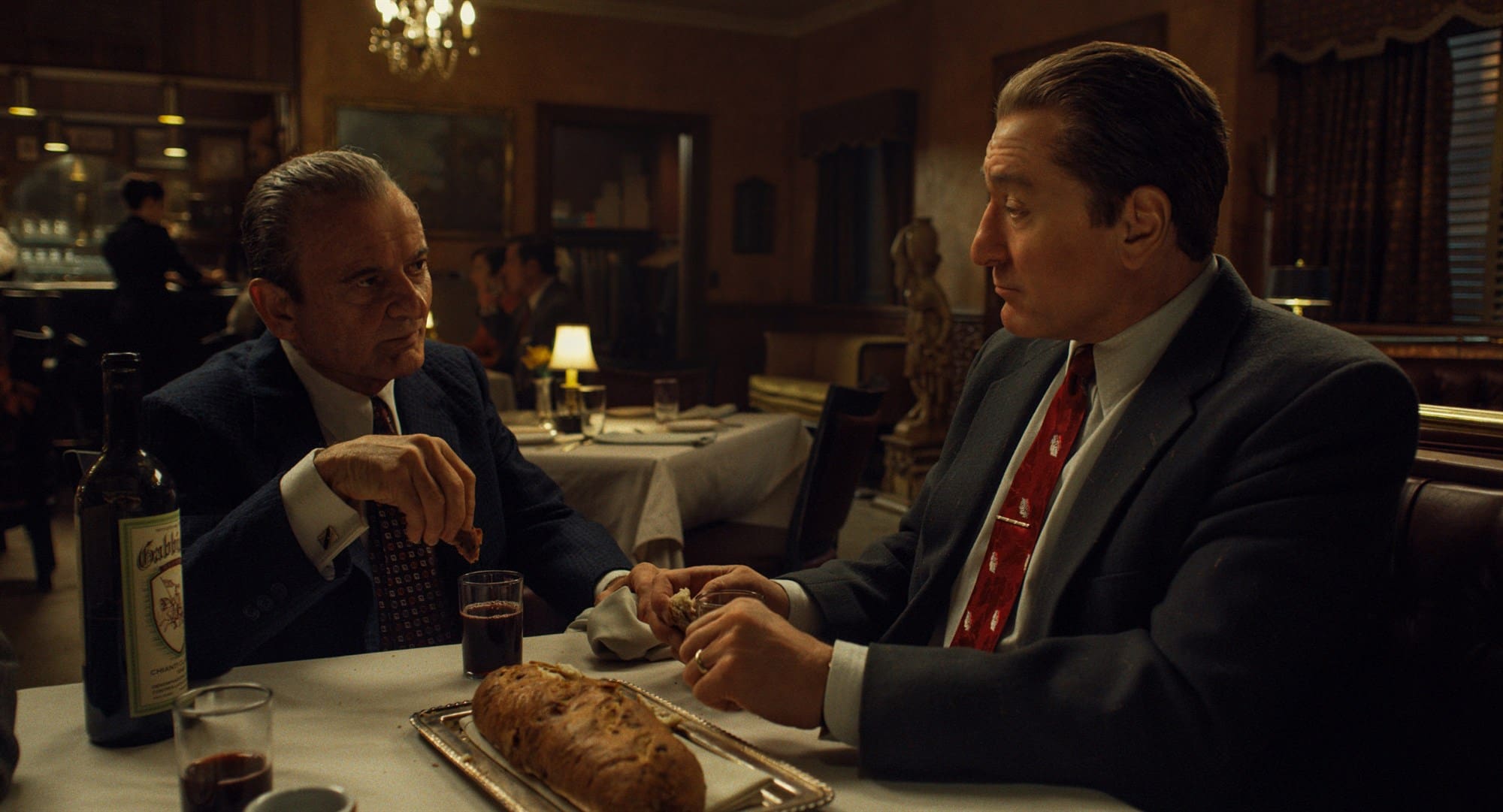
It’s foolish to say that Martin Scorsese has only directed gangster movies — a claim thrown around by silly fanboys pretending to care about film while their knowledge of cinema begins and ends with the MCU. But his career is certainly defined by the subgenre — even if calling them “gangster movies” is a bit simplistic. These films are all explorations of masculinity, often in Italian American communities. His new film, The Irishman, serves as something of a thesis statement on the topic, taking the themes Scorsese is famous for exploring and taking them to a powerful conclusion.
The film follows WWII veteran turned mob hitman Frank “The Irishman” Sheeran (Robert De Niro), who had a long career “painting houses” for notorious figures in the New York crime scene, including Jimmy Hoffa (Al Pacino). He had a storied career, and much of the film’s notorious 209 minute runtime is dedicated to exploring it. Frank narrates his career in flashback from a retirement home circa the early 2000s, often returning to one particularly noteworthy hit he carried out in 1975 that viewers slowly learn more about as the film goes along. It’s a tricky narrative, but Scorsese’s frequent editor, Thelma Schoonmaker, does a nice job jumping between timelines while still keeping the linear story of Frank’s career clear.
What’s less clear is why the film made the odd decision to use de-aging technology for the flashbacks instead of casting younger actors or at least using makeup. There have been stunning developments made on the technological front when it comes to such effects, but the work here feels cheap — the characters almost look like something from a PS3 game. But the real issue isn’t how believable they look: it’s that it doesn’t make much of a difference in distinguishing the different timelines. When de-aged, De Niro and his costars simply look like they’ve had some wrinkles removed, and their touched up faces look the same no matter what decade they’re supposed to be in. It’s distracting, unnecessary, and truly the film’s only big problem.
For about two hours, The Irishman is a perfect distillation of what made Scorsese the king of a particular genre. We’ve seen him do this before, but it’s still a very compelling and well-made walk through history. The performances are uniformly strong, and the script by Steven Zallian balances comedy and drama effectively. It’s hard not to feel a bit overwhelmed by all the details being thrown at you, and it feels at times like it could work better as a limited series. But for the most part it’s great filmmaking.
But then that final act starts and suddenly we see why Scorsese chose to tell this story, and what makes it different from the other films in his oeuvre. Without venturing into spoiler territory, an aging Frank is confronted with the reality of his career, and the sheer pointlessness of all the violence he’s committed in the name of a ridiculous mob enterprise. And it’s all beautifully devastating. Scorsese has long been obsessed with the evils that Italian masculinity will drive men to do, and this feels like his magnum opus on the subject. Two moments near the end–both in which Frank speaks with his adult daughters–are simple but cut deep and the movie’s final shot will surely stick with audiences after the credits roll. To make a viewer feel intense sadness for characters that are absolutely unsympathetic is a tricky task, but Scorsese certainly knows how to find tragedy in the weakness of man, and not the man himself. This is some of the best filmmaking of his career.
Much of the buzz around the film is, of course, that De Niro, Pacino, and Joe Pesci all share the screen—and they’re all impressive in their own right. De Niro initially appears on auto-pilot, but his physical work in the film’s final chapter is painful to watch and well performed. This is also a smartly calibrated performance from Pacino. He’s still big and loud, but you can see when he’s performing his ferocity and when he’s genuinely intimidating. But Pesci may be the strongest of the core trio. He initially seems so small and harmless, but becomes quietly terrifying without needing the intense moments of violence he’s given in Goodfellas. And there are many other strong supporting performances in the film from great actors, but the one specifically worth highlighting is Anna Paquin’s, who plays one of Frank’s daughters. She only has six lines in the whole film and her first four scenes are performed entirely without dialogue. But what she’s capable of communicating without speaking is astounding.
Watching the film, I was reminded of another crime drama from 2019: Hustlers, directed by Lorene Scafaria. They’re about very different kinds of crimes, yes, but that female-led film served as an exciting twist on the tropes that Scorsese made famous. Having these two films released in the same year feels something like an unofficial passing of the torch. This feels like the last word he could possibly have to say on the subject, and having it serve as some form of punctuation on the genre that defined his career feels fitting and poetic. The men of the criminal underworld have had their time, and have been revealed as nothing more than pathetic boys acting violently due to a misplaced sense of nobility. It’s time for new stories, and new exciting directorial voices. But at least they went out with a bang.


Comments are closed.